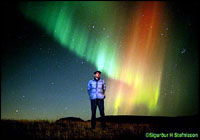Nasa craft probe mysteries of the northern lights
|
The shimmering waves of colour of the northern lights are a display
unparalleled in nature, caused as the Earth's atmosphere is buffeted by
energetic particles from magnetic storms in space. For scientists,
however, the lights also represent one of the longest-standing
mysteries in space physics: how and where in space do the displays
begin? And how can they be predicted?
Nasa has launched five identical spacecraft from Cape Canaveral in Florida in an attempt to answer the question. By measuring how the magnetic field around the Earth fluctuates in real time, the Themis project will allow scientists to better predict the weather in space that lies behind the northern lights -- crucial for keeping communications satellites and, eventually, humans safe in orbit.
The northern lights -- aurora borealis -- are a visual representation of the turmoils of the Earth's magnetic field. The sun continually streams energy towards our planet, some of which is stored by the Earth's magnetic field at heights of 10 000 km above the surface. The field creates a protective sheath for the Earth in space, called the magnetosphere, which shields our planet from much of the deadly radiation coming from the sun. But every so often, the field will release the energy it has stored and shower energetic electrons towards the upper atmosphere. When these hit air molecules, the energy released causes a characteristic glow.
"The colours represent the composition of the air at that height," said Mike Hapgood, head of the space plasma group at Rutherford Appleton Laboratory in Oxfordshire. "Green and red is the oxygen glowing, violet is nitrogen."
Substorms
Most of the time, the northern lights make up a steady band stretching from east to west but every few hours the energy released by the magnetic field intensifies into a substorm.
"It becomes interesting when a substorm goes off -- it brightens and then, within 30 seconds, it starts rushing towards the north. It engulfs the entire sky and breaks up into little pieces," said Vassilis Angelopoulos, principal investigator on the Themis project who is based at the University of California, Berkeley. "It's a magnificent phenomenon to watch."
The sequence of events that leads to a substorm is unknown. "The problem so far is that a single satellite was never able to pinpoint the exact trigger of this process," said Angelopoulus.
The five Themis satellites are designed to orbit the Earth in such a way that they line up along the sun-Earth line every four days, tracking the flow of energy from one to the other. Possible triggers for the substorms have different locations in space, so placing the Themis spacecraft in various locations in the Earth's magnetic field will help find the elusive point of origin.
"The orbits are designed so that there will be a series of spacecraft down the tail of the Earth's magnetic field at the same time," said Hapgood. "They'll be able to bracket the different phenomena occurring. They'll be able to say, 'this thing happened between these two spacecraft at this time'."
More than 20 ground stations across the US will track the Themis satellites, to give precise locations for the magnetic substorms that are observed. Themis will also work with the European Cluster project, launched in 2000, which uses four satellites flying in tandem to measure the Earth's magnetic field.
"Cluster has been important -- we've been sending information to our US colleagues on how to coordinate it with Themis," said Hapgood. As well as the northern lights, the European Cluster project uses 11 instruments to focus on the part of the Earth's magnetic field that faces the sun, called the bow shock.
"Much like meteorologists study tornadoes in order to understand the large thunderstorms, so we study substorms to get better insight into large space storms," said Angelopoulos.
Predicting these storms is important for scientists to describe the environment around the Earth and ensure spacecraft and astronauts can operate safely, as the particles created in the storms can damage electronic circuits.
Early warning
The radiation can also knock out power grids on the Earth's surface. "Once they [Nasa] have the timing right, it becomes much easier to give people a warning," said Hapgood. "If you give a control centre half an hour's notice, they can be alert and ready to deal with things or issue a warning saying things aren't going to be so reliable for the next few hours."
Modern warnings of space storms are unreliable. "It's like what weather forecasting may have been a century ago. Over the last 50 years, it has evolved rather dramatically because they understand the sequence of events much better. Essentially we are doing the same sort of thing, trying to understand that sequence and give people more accurate predictions."
The Themis satellites will spend the next few months being carefully arranged in space, and will make their first working measurements in a year's time. They are scheduled to operate for two years.
Hapgood said that understanding the Earth's magnetic field will also give scientists insights into other planets in the solar system that have magnetospheres: "These things also happen out further in the universe around pulsars. Understanding how magnetospheres work is a universal question."
Source: Guardian Unlimited © Guardian News and Media Limited











